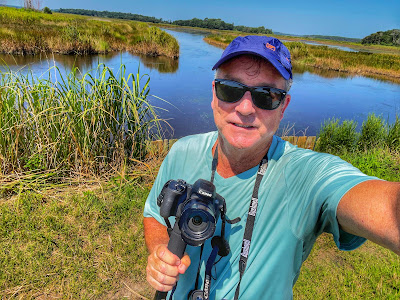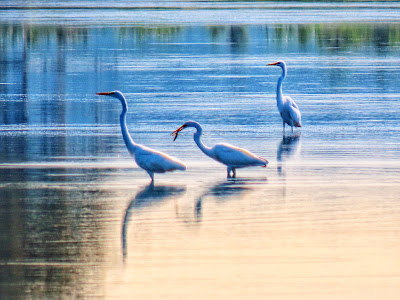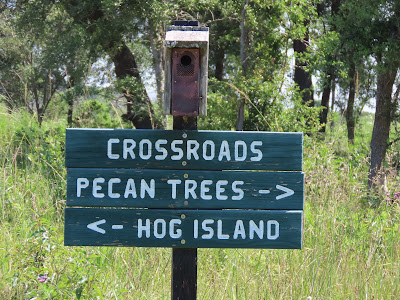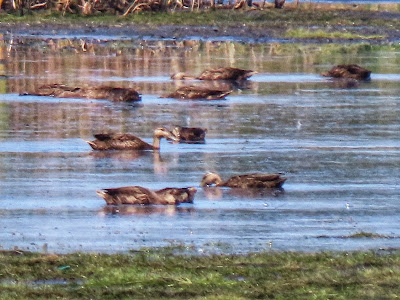On Wednesday, June 28 I finally made the trek down to Green Pond in the ACE Basin. I had the itch for months and the right day was there so off I went.
The 12,000-acre Bear Island Wildlife Management Area was the destination. From my house it’s about 45 miles to the left turn off Highway 17 (Bennett's Point Road) then another 15 miles or so to the entrance to the vast nature preserve.
I received a nice greeting near the gate from this friendly hen that walked up to my car. It seemed to belong to the home situated just outside the preserve.
This had to be an omen that good birding was ahead for me.
I identified this as a Pedresa Chicken using a bird ID app I'm trying out called Picture Bird. I open the app, bring in my bird photo and in seconds it tells me the type of bird. This was helpful in this outing to confirm birds I have seen before and to help with identities I was not so sure about.
Just inside the entrance is a large body of water called Mary’s House Pond.Past visits have taught me there are usually some large wading birds here.
And sure enough, I spotted Great Egrets and Great Blue Herons.
I tried out some different photo processing tools in my favorite Snapseed app.
One Great Egret caught a small fish. I’m surprised how shallow the water is even way out to in the middle of Mary’s House Pond.
Below I used Snapseed’s “Morning” which is among the many “Looks” offerings. Snapseed is an awesome iPhone photo editing app that is free.
A pair of Common Moorhens took off when I got a little too close for their comfort.
An Anhinga (aka Devil Bird) flexes in a common pose it shares with close cousin Cormorant. It’s drying and/or trying to stay a little cooler on a day when temperatures were in the low 90s.
While I walking along Mary’s Pond this alligator crossed the road. Well ahead of me thank goodness.
Alligators are all around these Lowcountry nature preserves- all around the Lowcountry everywhere for that matter.
They are in the many waterways and in the reeds and high grass next to them.It is wise to be very alert in every step you take out here in the wild!
Gators are among the most numerous critters here. On this day so were Dragonflies. They didn’t bother me but the bugs did some so I carried spray in my back pocket and applied it right after arriving and several times after when the bugs were, well, bugging me.
After Mary’s House Pond I drove all the way to where Bear Island WMA ends. It’s a few miles down this straight dirt road.
Once there I parked and went down the closed-to-motor vehicles path on both sides of the road. Here you see what used to be rice fields that back in the 18th and early 19th centuries enslaved Africans toiled away making their White owners wealthy.
A Boat-tailed Grackle at attention on a wooden trunk. These trunks were and are still used to control the flow of water from the Edisto River.
The ACE in ACE Basin stands for the vast region where three rivers- Ashepoo, Combahee and Edisto converge to create a robust watershed ecosystem that today is protected from development by an array of federal, state and local governments and other entities.
A Red-winged Blackbird perched on a power line. These cables along the main road are a good place to observe and photograph smaller birds.
We have these blackbirds at our backyard feeders.
This is a female Red-winged Blackbird.
In this back part of Bear Island there were lots of alligators in the water and in the high grass. One splashed in the water with a loud thump when I walked not too far away.
The birding wasn’t great back there so I moved on.
To me, better trials like this one take you by old rice canals and ponds of different sizes. If you are looking for birds, look for water.
Old Wooden Trunk and Hog Island were the hot spots for birds on this hot day. They were target-rich environments for me and my camera!
In these photos, you will see Tricolored Herons, Snowy Egrets, Glossy Ibis, Black-necked Stilts and other species gathered for this party!
The Glossy Ibis in the foreground below is the colorful one with the reddish neck and white eye ring.
For these next two photos I set my Canon camera to a creative filter called “art bold" that can make a photo look like an oil painting. I used this setting to photograph Barred Owls in my yard recently. See that post here.
(Below) I’m not sure what these wood structures used to be part of but today they make nice perches for, from left a Great Egret, Boat-tailed Grackle, and Snowy Egret. The small bird in the middle back I think may be a shore bird, possibly a laughing gull.
Glossy Ibis
A favorite photo: Tricolored Heron pair
A Tricolored Heron in attack mode.


Mottled Ducks
I am trying this app called Picture Bird. It’s a bird identification app. I used it to help with this duck and the one after it.
Mottled Ducks are medium-sized dabbling ducks. They are also called Mottled Mallards. As this site explains, "Dabblers (also called puddle ducks) ride high along the water, skimming the surface for food. They'll tip their head underwater and stick their bottoms straight up in the air while noshing on seeds, grains, plants, insects and worms." The Mottled Duck (below) wasn’t noshing at the moment of this capture.
Crabs on a muddy bank.
This old house on Bear Island seems to be abandoned. It is located not far from the entrance near a storage and maintenance facility.
I noticed an occupied Osprey nest on the way to Bear Island and stopped there on the way back.
The site on the Ashepoo River is of historic significance, per the sign at the base of the bridge. In May 1864 during the Civil War a Union effort to destroy a Confederate railroad trestle led to a rescue mission by soldiers of the U.S. Colored Troops. Their leader, Lt. George Brush, would be awarded the Medal of Honor for his bravery. Learn more here. Also, this may be the remains of the train trestle shown in my photograph above.
Not until I returned home and uploaded my pictures did I see that there are two baby Ospreys in the big nest carefully controlled by the parent. Look closely and/or make the photo above larger to see two little heads beneath the parent.
Best of luck to this Osprey family. Live long and prosper, as Spock would say!
For this last image of a Red-winged Blackbird, I used Snapseed’s silhouette effect. Cool look right?


My car did well with some rugged driving in the remote treasure that is the Bear Island Wildlife Management Area (operated by the S.C. Department of Natural Resources).
























































No comments:
Post a Comment